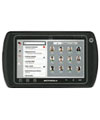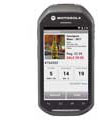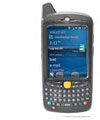October 1, 2013 — the day Moto Solutions and Honeywell/Intermec became serious about Android
This has been quite the day for Android in the rugged handheld space.
Intermec, now part of Honeywell Scanning & Mobility, announced the CN51 rugged mobile computer. It is an updated version of Intermec’s successful CN50, but has a larger, higher resolution screen (4.0-inch, 800 x 480) that now uses resistive multi-touch, updated WiFi, WAN, Bluetooth, camera, and scanners, and it’s now based on the dual-core 1.5GHz TI OMAP 4 processor, which means Intermec can offer the CN51 either with Microsoft Windows Embedded Handheld 6.5 OR with Android 4.1.
And Motorola Solutions, the same day, announced that three of its popular enterprise mobile computers would now be available with Android Jelly Bean, fortified with Moto’s own Mx security, device management and performance features that they added to the standard Android OS. So as a result, the following three Motorola Solutions devices will now be available with Android Jelly Bean:
|
Motorola Solutions Android mobile computers |
| Product | ET1 | MC40 | MC67 |

|

|

|
|
| Type | Enterprise tablet | Rugged Handheld | Enterprise PDA |
| Display | 7-inch (1024 x 600) | 4.3-inch (480 x 800) | 3.5-inch (480 x 640) |
| Digitizer | Capacitive multi-touch | Capacitive | Resistive |
| Original OS | Android | Android | Embedded Handheld 6.5 |
| Available OS | Android Jelly Bean | Android Jelly Bean | Android Jelly Bean |
| RAM | 1GB | 1GB | 1GB |
| Storage | 4GB Flash + microSD | 8GB Flash | 8GB Flash |
| Size | 8.8 x 5.1 x 1.0 | 5.7 x 2.9 x 0.8 | 6.4 x 3.0 x 1.3 |
| Weight | 1.4 lbs. | 9.4 oz. | 13.5 oz. |
| CPU | 1GHz OMAP 4 | 800MHz OMAP 4 | 1GHz OMAP 4 |
| Scanning | via 8mp camera | SA4500-DL | SE4500-SR/DL/DPM |
| WWAN | Data-only | NA | Voice and data |
| Op. temp | 32 to 122F | 32 to 122F | -4 to 122F |
| Sealing | IP54 | IP54 | IP67 |
Motorola Solutions points out that their three Android offerings are not only benefitting from the Mx extensions (see Mx website), but also from the company’s RhoMobile Suite (see RhoMobile page), a cross-platform development tool used to create apps that are OS-independent. Which means the Moto Android devices can run standard Android apps, or HTML 5 cross-platform apps created with RhoMobile.
Here’s what Motorola Solutions had to say about the emerging Android devices:
And below is Intermec’s introduction to their CN51 that can run both Windows Mobile and Android:
What does it all mean, this pretty high visibility push of Android in business and enterprise class devices? Well, there’s the odd situation that while almost all smartphones are either iPhones or Android devices, virtually all industrial handhelds still run one version of Microsoft’s old Windows CE or Windows Mobile or another. Which means that most industrial handhelds are by no means ruggedized equivalents of the smartphones a good part of humanity already knows inside out. Which results in extra training, an extra learning curve, and the near certainty that change will come anyway. Up to now, rugged mobile computing manufacturers have been remarkably conservative in acknowledging that trend, and generally limiting themselves to offering an exploratory Android version or two of a Windows device running on similar hardware. What we’re now beginning to see is the next step, that of making the hardware so that it can run both old and new.
Now, no one wants to alienate Microsoft, of course, and so things are worded carefully. Intermec’s press release includes a quote from industry analyst David Krebs, VP of mobile & wireless at VDC: “While rugged devices are designed to be more function or application-specific than smartphones, there is growing consensus that these devices deliver a similar immersive experience and have similar capabilities as function-rich smartphones. As Android matures in the enterprise it represents an increasingly viable option for rugged vendors such as Intermec to bridge this functionality gap and deliver the capabilities their partners and customers are looking for.”
On the Motorola Solutions side, Girish Rishi, Senior VP of enterprise solutions, said, “Now, businesses have more choices and can better manage rapid changes in the market by using Motorola’s tools that deliver complete solutions in less time while protecting their mobile investments.’
It’s fairly safe to assume that these are just first steps. The proposed hardware still represents compromises and is not (yet) truly Android optimized. But the message communicated by both Intermec/Honeywell and Motorola Solutions is quite clear: We can’t wait any longer, Microsoft. We need to get with the program before we lose our markets to consumer smartphones in a case.